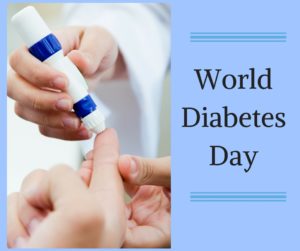
World Diabetes Day – a day to raise awareness about diabetes – is coming up on November 14th. Did you know that there are two types of diabetes? Type 1 Diabetes is an autoimmune condition. This means that the body’s immune system ‘turns on itself’, creating dysfunction. In Type 1 Diabetes, a person’s immune system attacks beta cells in the pancreas, an organ which produces insulin. This means that the pancreas produces little, if any, insulin, which results in decreased ability for the body to deal with glucose in the blood stream. Type 2 Diabetes is a chronic condition that results in part from abnormal insulin secretion, and in part due to insulin resistance, meaning that the body has difficulty using insulin appropriately. (Type 2 Diabetes is the more common diagnosis, accounting for 90-95% of all diabetes cases.) The issues associated with Type 2 Diabetes cause excess glucose to build up in the blood stream. It is important to treat both Type 1 and Type 2 Diabetes appropriately. If glucose is not managed appropriately in the body, problems such as heart disease, kidney disease, and nerve damage can occur.
Here are Some Common Symptoms of Diabetes
- Frequent urination
- Feeling thirsty
- Feeling very hungry (even when eating normally)
- Extreme fatigue
- Blurry vision
- Cuts/bruises that are slow to heal
- Weight loss, even when eating more than usual (Type 1)
- Tingling, pain, or numbness in hands/feet (Type 2)
U.S. Diabetes Statistics (according to the American Diabetes Association)
- Prevalence: In 2015, 30.3 million American’s, or 9.4% of the population, had diabetes. Approximately 1.25 million American children and adults have Type 1 Diabetes
- Undiagnosed Cases: Of the 30.3 million adults with diabetes, 23.1 million have been diagnosed, and 7.2 million are estimated to be undiagnosed
- Prevalence in Seniors: The percentage of Americans age 65 and older with diabetes is quite high, at 25.2% or 12 million seniors
- New cases: 1.5 million Americans are diagnosed with diabetes every year
- Prediabetes: In 2015, 84.1 million Americans age 18 and older had prediabetes
- Deaths: Diabetes is the 7th leading cause of death in the U.S. as of 2015, with 79,535 death certificates listing diabetes as an underlying cause of death, and 252.806 death certificates listing diabetes as an underlying or contributing cause of death
How to Reduce the Risk of Diabetes
- Lose excess body fat
- Being overweight is a big risk factor for diabetes. However, every kilogram (2.2 lbs) of weight lost reduces risk for diabetes by 16%
- Follow a plant-based, low-calorie diet
- Eating a variety of fruits and vegetables is shown to reduce risk of diabetes; while eating foods with high trans fats, saturated fat, and sugar should be avoided
- Drink water
- Sugar-sweetened beverages are shown to increase the risk of obesity and diabetes
- Stay active
- Physical inactivity increases the risk for diabetes, while exercise renders cells more sensitive to insulin. Moderate exercise, such as walking briskly, for 150 minutes/week is shown to reduce risk of diabetes
- Sleep well
- Chronic sleep deprivation and/or poor quality of sleep increases the risk for diabetes and obesity
- Maintain regular medical appointments
- Sometimes it is difficult to see the warning signs for diabetes, especially Type 2 Diabetes. It is important to go to regular MD appointments to make sure your glucose and insulin levels are normalWoW
Unfortunately there is no cure for diabetes. However, because there are ways to reduce your risk of diabetes, as well as ways to treat symptoms as well as the progression of the disease, it is currently possible to manage diabetic conditions effectively. Your doctor and your physical therapist can help you to establish appropriate individual strategies to reduce risk or the effects of diabetes through diet, exercise, and medications.
For More Information about Diabetes, Check out These Resources:
- World Health Organizations Diabetes Fact Sheet
- Change Your Ways, Reduce Your Risk: 7 Tips for Preventing Diabetes
- American Diabetes Association Statistics on Diabetes
